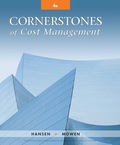
1.
Compute the optimal batch size for HA2 under EOQ model and indicate whether Company B’s response over the customer rights is correct or not.
1.
Explanation of Solution
Economic order quantity (EOQ): Economic order quantity is ideal order quantity that the company should purchase the inventory with the ideal level. The economic order quantity (EOQ) approach assumes that some inventory must be held for future production. The main objective of the EOQ is to balance the ordering costs against the holding costs of inventory.
Compute the optimal batch size for HA2 under EOQ model and indicate whether Company B’s response over the customer rights is correct or not as follows:
Hence, the optimal batch size for HA2 under EOQ model is 12,000 units.
Description:
Company B’s response over the customer rights is correct for the current production environment, because the setup time is two days for the production and company has produced 750 units per day. Thus, the time required to produce the additional 9,000 units is 14 days (1).
Working note (1):
Calculate the time required to produce the additional 9,000 units.
2.
Compute the additional inventory that is needed to meet the customer requirements and indicate whether company B should carry more inventories.
2.
Explanation of Solution
Compute the additional inventory that is needed to meet the customer requirements and indicate whether company B should carry more inventories as follows:
In this case, company B would have produced 3,750 units (2) within the seven working days whereas company has 5,250 units
Working note (2):
Calculate the number of additional units.
3.
Calculate the new optimal batch size under economic order quantity (EOQ) model and new lead time, and indicate whether company B would have been able to meet the customer’s time requirements.
3.
Explanation of Solution
Calculate the new optimal batch size under economic order quantity (EOQ) model and new lead time, and indicate whether company B would have been able to meet the customer’s time requirements as follows:
Economic order quantity:
New lead time:
Description:
In this case, company B could satisfy the customer’s time requirement in less than 7.5 hours at a production rate of 2,000 units per day. Above calculation indicates that the company should take attention on setup, moving and waiting activities to reduce the lead time of production. Just in time method would provide easy way to reduce the lead time of production with the help of shorter production cycle. EOQ reveals that the batch size has reduced to 13%
4.
Calculate the batch size if set up time and cost are reduced to 0.5 hour and $10 respectively, calculate the batch size if set up time and cost are reduced to 5 minutes and $0.864 respectively and comment its implication.
4.
Explanation of Solution
Calculate the batch size if set up time and cost are reduced to 0.5 hour and $10 respectively as follows:
Reduced setup time and cost would reduce the batch size to 490 units.
Calculate the batch size if set up time and cost are reduced to 5 minutes and $0.864 respectively as follows:
If cost is reduced to 0.864, then batch size is reduced to 144 units.
The demand units per day can be produced in less than one hour with the ability to produce 2,000 units per day.
Want to see more full solutions like this?
Chapter 20 Solutions
EBK CORNERSTONES OF COST MANAGEMENT
- Please provide problem with general accounting questionarrow_forwardDoes digital accounting eliminate the need for Internal Control or does digital accounting further enhance the need for Internal Control? What challenges do auditors face while understanding the Internal Control where the company's accounting system is highly digitalized?arrow_forwardHiarrow_forward
 Cornerstones of Cost Management (Cornerstones Ser...AccountingISBN:9781305970663Author:Don R. Hansen, Maryanne M. MowenPublisher:Cengage Learning
Cornerstones of Cost Management (Cornerstones Ser...AccountingISBN:9781305970663Author:Don R. Hansen, Maryanne M. MowenPublisher:Cengage Learning Managerial Accounting: The Cornerstone of Busines...AccountingISBN:9781337115773Author:Maryanne M. Mowen, Don R. Hansen, Dan L. HeitgerPublisher:Cengage Learning
Managerial Accounting: The Cornerstone of Busines...AccountingISBN:9781337115773Author:Maryanne M. Mowen, Don R. Hansen, Dan L. HeitgerPublisher:Cengage Learning Essentials of Business Analytics (MindTap Course ...StatisticsISBN:9781305627734Author:Jeffrey D. Camm, James J. Cochran, Michael J. Fry, Jeffrey W. Ohlmann, David R. AndersonPublisher:Cengage Learning
Essentials of Business Analytics (MindTap Course ...StatisticsISBN:9781305627734Author:Jeffrey D. Camm, James J. Cochran, Michael J. Fry, Jeffrey W. Ohlmann, David R. AndersonPublisher:Cengage Learning


